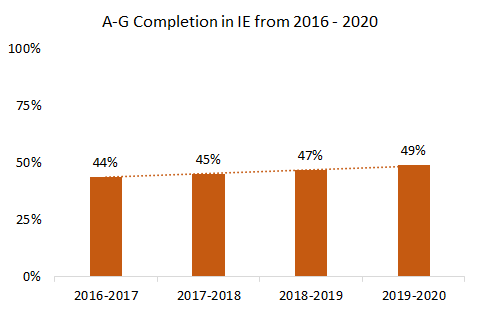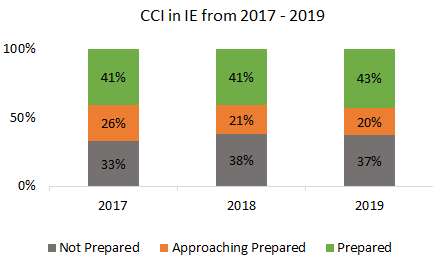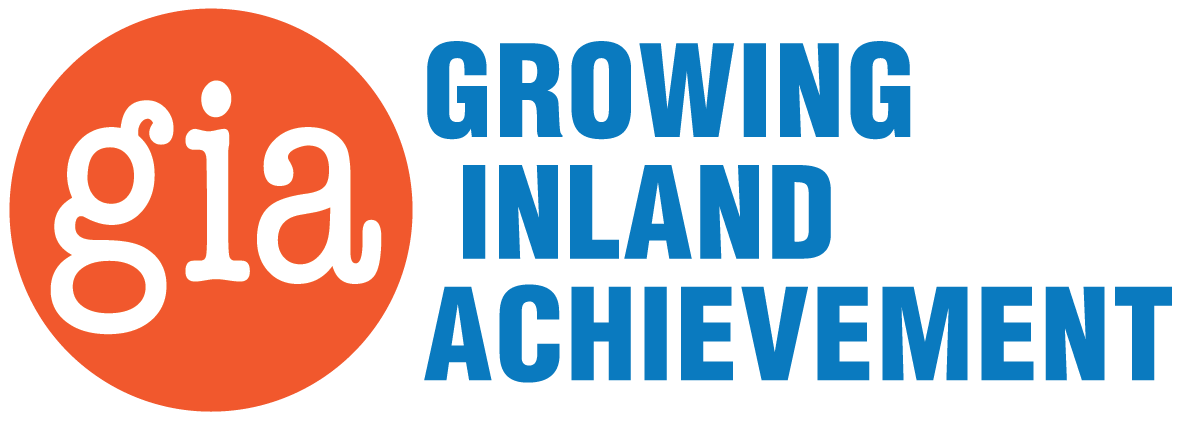action network teams
College & Career Readiness
The College & Career ANT meets the third Thursday of each month to increase the number of students enrolled in the A-G required courses and to ensure students are prepared for the demands of college or their career of choice. They are currently focused on two initiatives: Magnify the Middle and an upcoming project on college preparation mindset.
For more detail on this work, please refer to the College & Career Readiness ANT Tactical Plan.
Improving college and career readiness is one of the regional goals set forth by the GIA education network for the Inland Empire. To make strides toward this goal, the College & Career Readiness ANT supports K-12 institutions to better prepare students for postsecondary education and/or a pathway to a productive career.
A college and career ready student is a student who qualifies for and succeeds in college courses or career-oriented training which ultimately leads to the conferral of a degree or certificate without remedial or developmental coursework.1 To be prepared for success, students must have content knowledge from their core subjects, cognitive strategies to problem solve through college-level work, learning skills and techniques (e.g., help-seeking, self-efficacy, ownership of learning), and transition knowledge (e.g., which courses to take in high school, financial aid, career pathways).1
Recently published metrics of IE students highlight that approximately half of students are college and career ready (see recently published metrics by district, school, and demographic characteristics here). For example, IE students are encouraged to take courses that will ensure they are eligible for admission at any college, particularly at a UC or CSU school. These subject requirements are known as the A-G requirements.2 In 2019-2020, 49% of students in the IE completed the A-G requirements (see Figure 1). Similarly, the College/Career Readiness Indicator (CCI), a state indicator of college and career readiness based on A-G coursework, test scores, and more, showed that 43% of students were considered “prepared” in 2019 (see Figure 2).3 It’s important to note that equity gaps remain for both indicators across race, ethnicity, gender, geographic location, and SES characteristics (see metrics here). To ensure initiatives aimed to improve A-G completion rates and CCI preparedness are equitable, specific attention is needed to support males, Black students, Hispanic students, English Learners, and students experiencing socioeconomic challenges.
Figure 1. A-G Completion Rates in the Inland Empire from 2016-2020

Source: California Department of Education DataQuest, data compiled by GIA
Figure 2. College/Career Readiness Indicator (CCI) in the Inland Empire from 2017-2019

Source: California Department of Education DataQuest, data compiled by GIA
Click an area below to jump to that section
1. Magnify the Middle
2. College Preparation Mindset (Upcoming Project)
3. Collaboration with Financial Aid ANT (Financial Literacy)
Magnify the Middle
Magnify the Middle is a program facilitated by the Riverside County Office of Education that aims to improve the preparation of middle school students so they are well-positioned to access high school A-G, Advanced Placement (AP), International Baccalaureate (IB), and dual enrollment courses. This program is founded on the idea that positioning students for success in high school, college, and beyond must begin prior to ninth grade. Previous research has found that middle school grades are a powerful predictor of college-going and college-success rates,4 and therefore college preparation programs should be implemented in middle school as students are starting to think about their educational futures during these years.5
This past year, the Magnify the Middle team has been working with 22 middle schools in Riverside County to examine student achievement through a newly developed High School Readiness Indicator (HSRI), modeled after high school A-G eligibility. The HSRI is based on an analysis of students’ middle school transcripts and facilitates a smoother transition between middle and high school success. By 2022, the program aims to increase the HSRI rates from 34% to 60% in the middle schools. For the 2021-2022 school year, the program will continue to engage all 22 middle schools in analyzing, reflecting, and acting on their HSRI rates. They will also be hosting two events for middle school students to help increase awareness, excitement, and preparation for high school and higher education.
This project was supported by funds from the GIA Innovation Awards.
College Preparation Mindset (Upcoming)
The College & Career Readiness ANT members are developing a new project that will target middle school (6 – 8 grade) students and their parents’ college preparation mindset. The college preparation mindset refers to the extent to which families believe college is connected to economic success, families understand what is needed to attend and graduate college (above and beyond coursework), and families are aware of the resources and tools available to make college a reality.
This mindset is important because previous studies have shown that most young people in the U.S. have high aspirations of going to college, but many do not attain their goals or persist to achieve their degree.5 This is particularly true for traditionally marginalized students of color in families with lower income or less education because they have fewer ties to the college preparation and enrollment processes (i.e., social capital).6, 7 Overall, the efforts in this project aim to promote equitable social capital so all families have the knowledge and resources to make college a reality.
To make a meaningful difference, members of the College & Career Readiness ANT will engage in a systems approach to promote the mindset. This means that educators, administrators, and school staff will be involved in distributing information and promoting the mindset to students and their parents. These efforts will be targeted towards schools with low A-G rates. Ultimately, these efforts aim to enhance the A-G rates in the IE. Stay tuned for upcoming developments in this project.
Collaboration with Financial Aid ANT – Financial Literacy
The College & Career Readiness ANT members are also collaborating with the Financial Aid ANT (FAANT) on an initiative to promote financial literacy in the IE. For more information on this, please check out our FAANT page.
Interested in Learning More?
Please reach out to Ida Hermosillo, Director of Network Engagement.
Prospective and current college students may also benefit from GIA’s college resource directory at https://iestudents.org/.
Check out this great content!
Many of our valued ANT team members are featured as guests on GIA’s podcast channels. Tune in and hear them talk about some of the educational challenges and opportunities facing the Inland Empire region and the tactical work that is being carried out by the network to drive transformation.
Sources
- Conley, D. T. (2012). A Complete Definition of College and Career Readiness. Educational Policy Improvement Center (NJ1).
- University of California Subject requirement (A-G) Webpage
- Understanding the College/Career Readiness Measure: Prepared. California School Dashboard.
- DiPrete, T. A., & Buchmann, C. (2014). The secret behind college completion: Girls, boys, and the power of eighth grade grades. Washington, DC: Third Way.
- Gibbons, M. M., & Borders, L. D. (2010). A measure of college-going self-efficacy for middle school students. Professional School Counseling, 13(4), 2156759X1001300404.
- Ryan, S. (2016). Ambitions in action: Investigating college enrollment among Hispanic youth who expect to complete a bachelor’s degree. Journal of Hispanic Higher Education, 15(1), 3-21.
- Zalaznick, M. (2020). Students face an ‘opportunity gap.’ Here’s how to close it. University Business.


